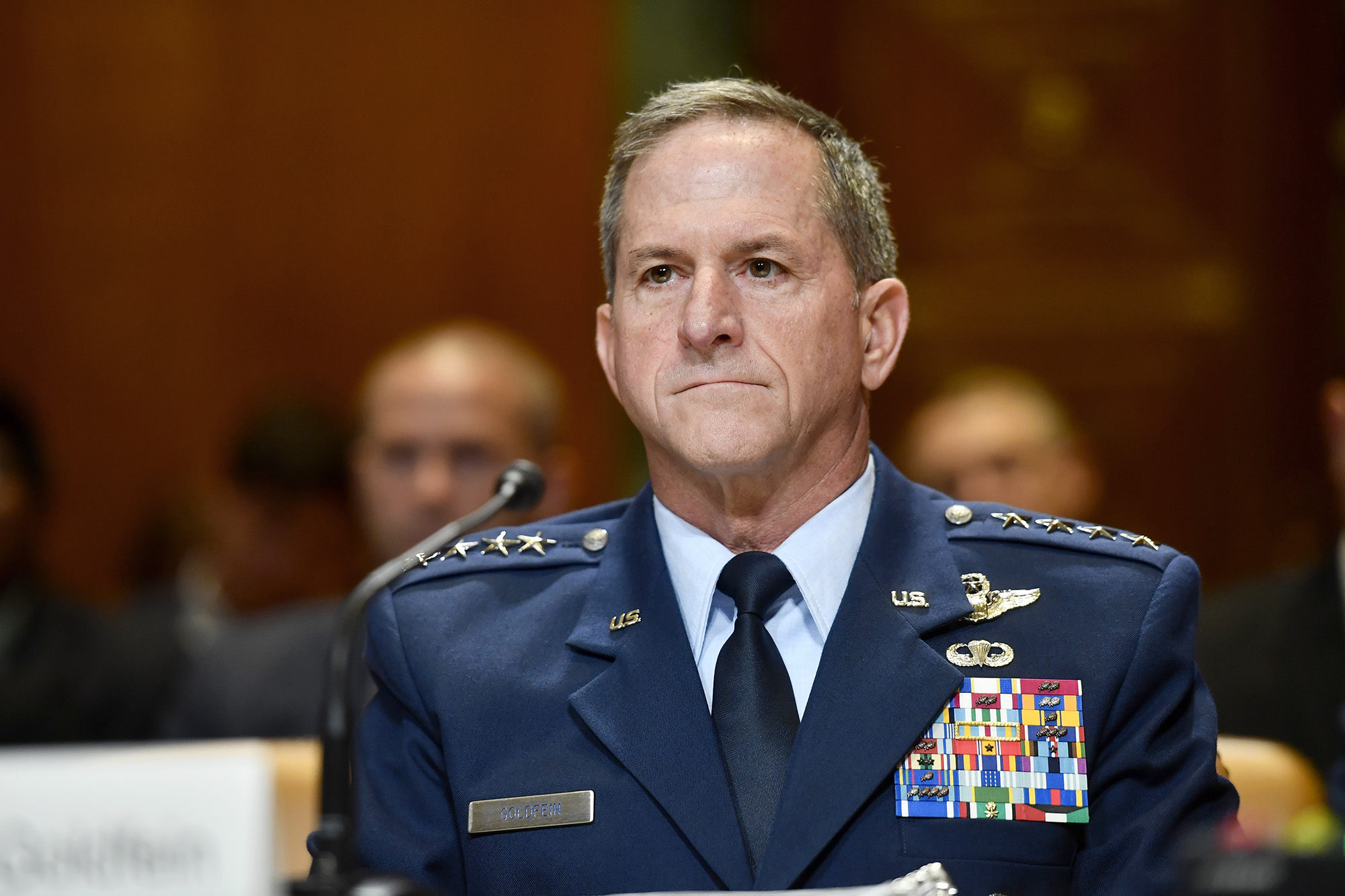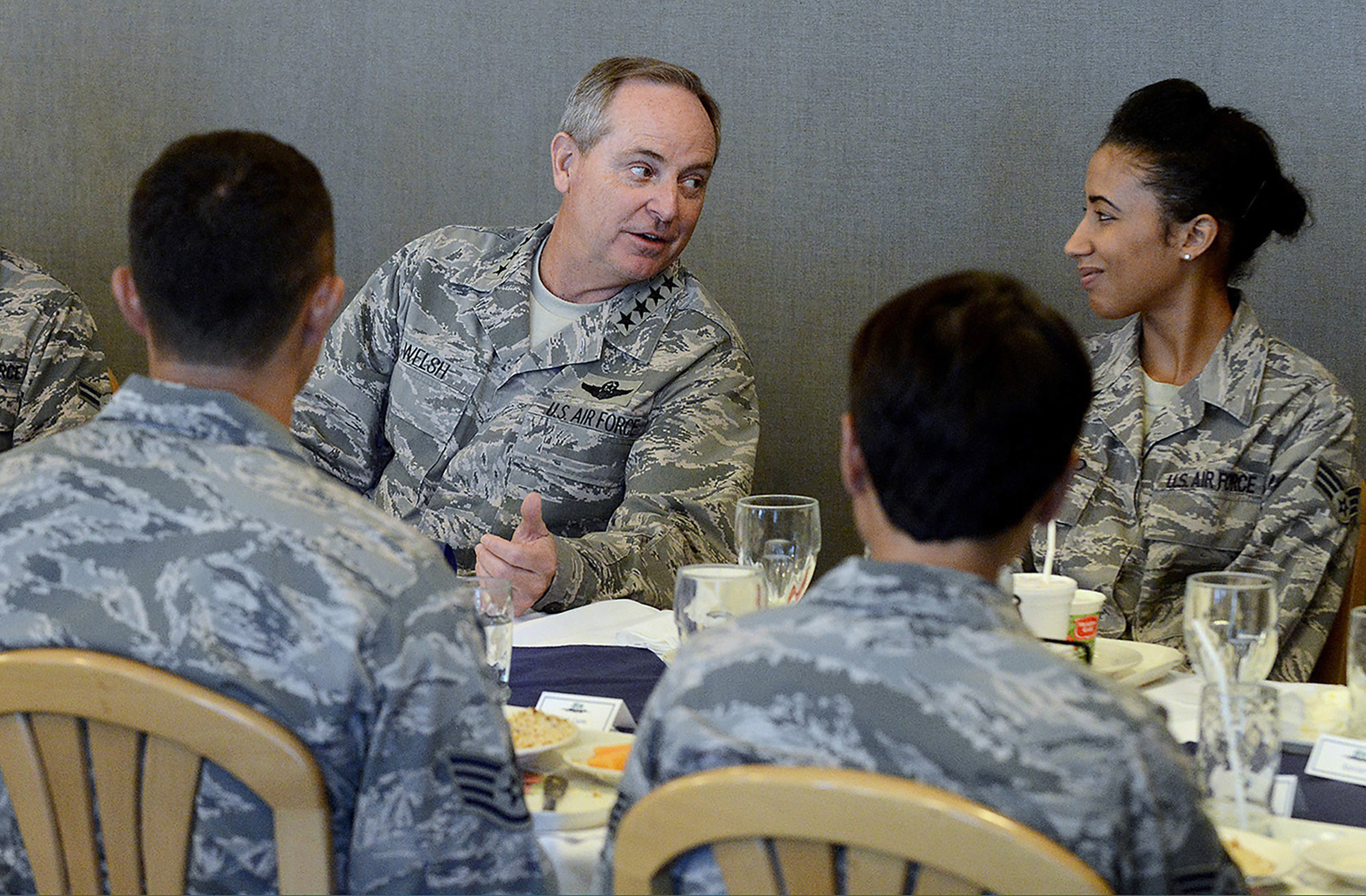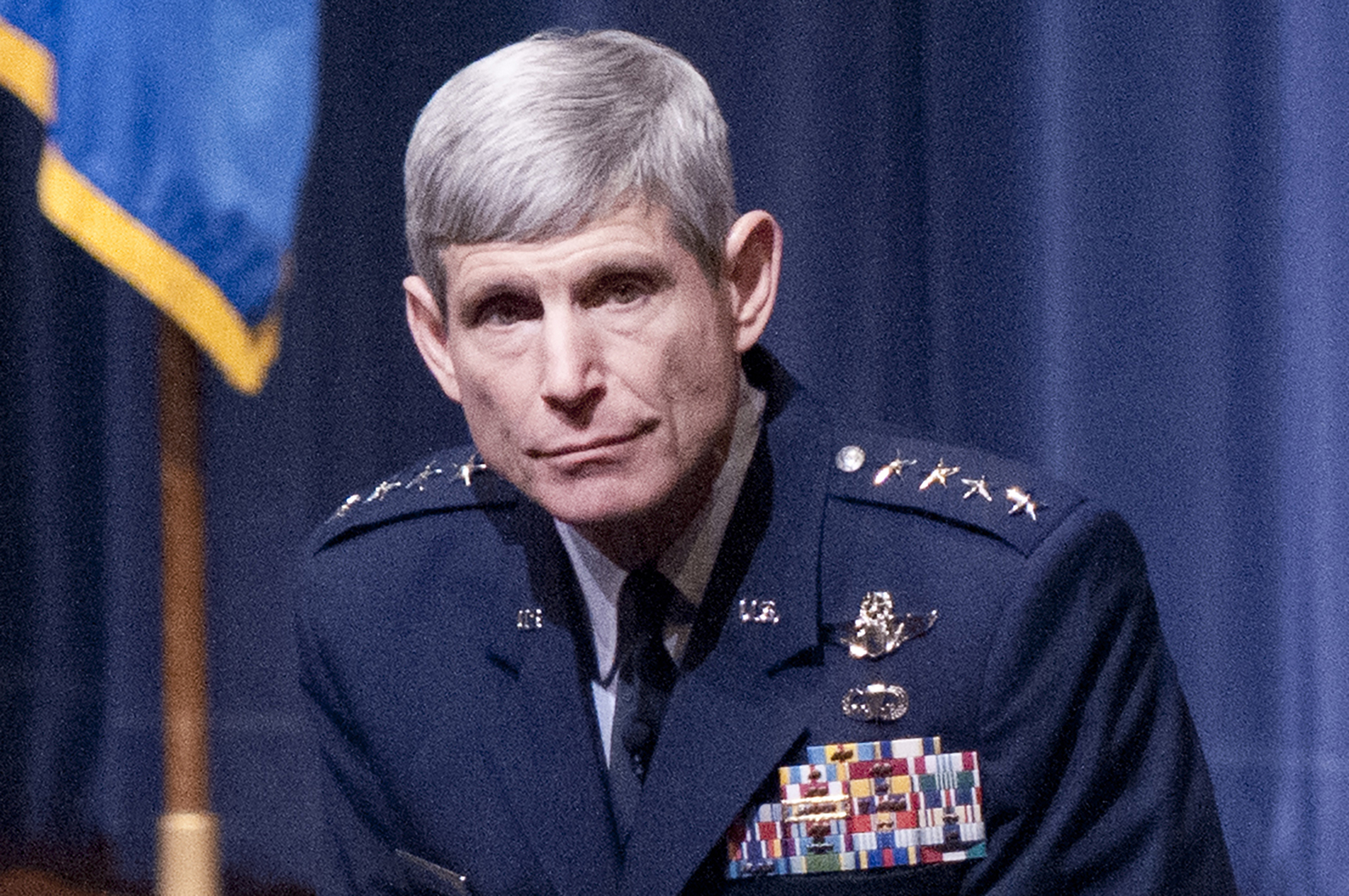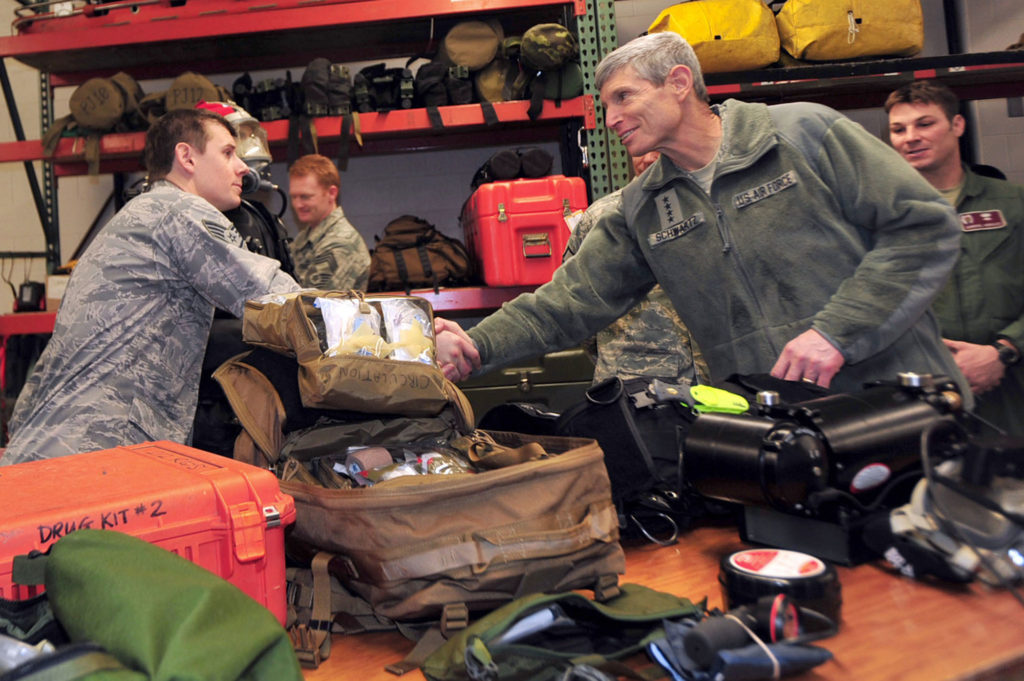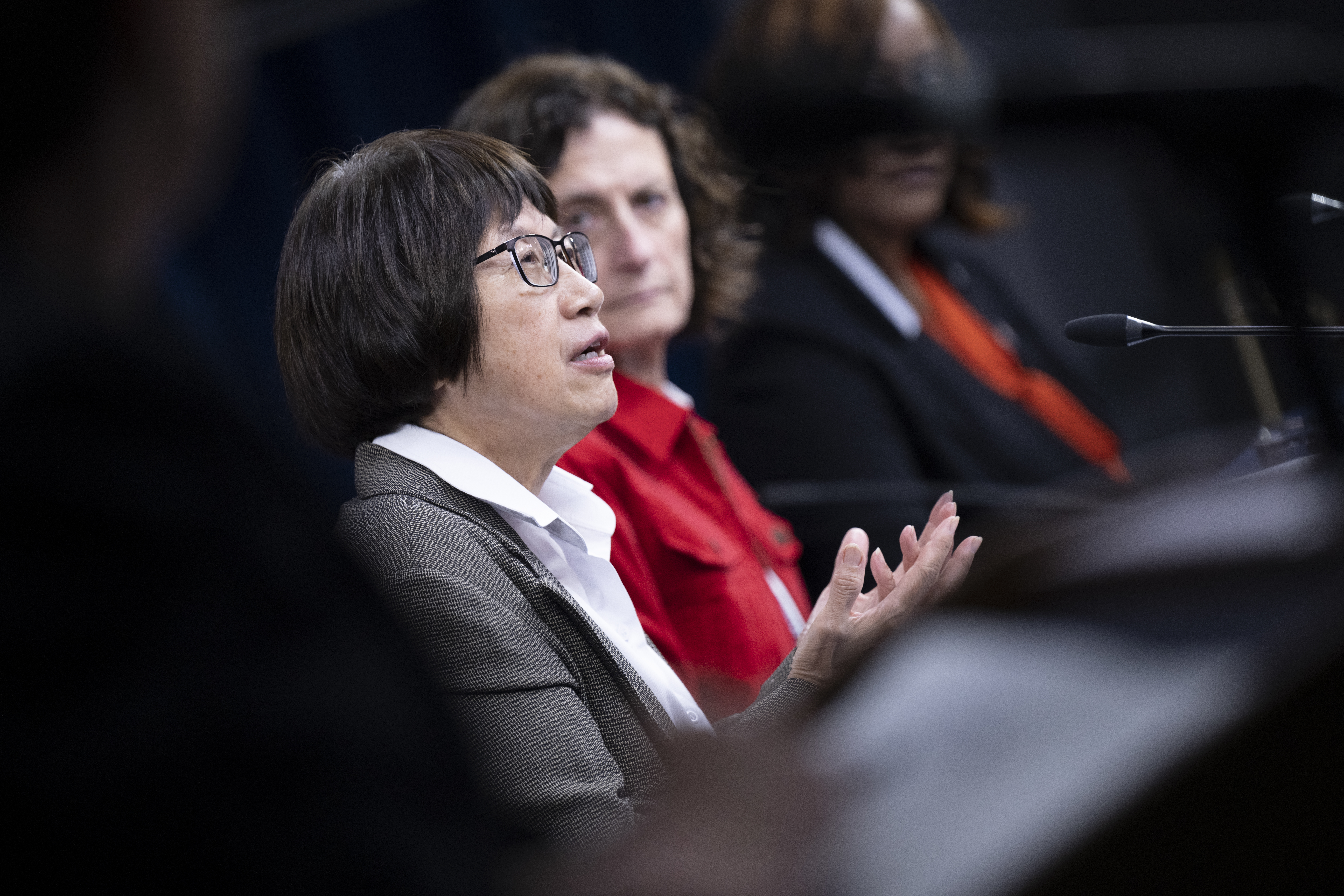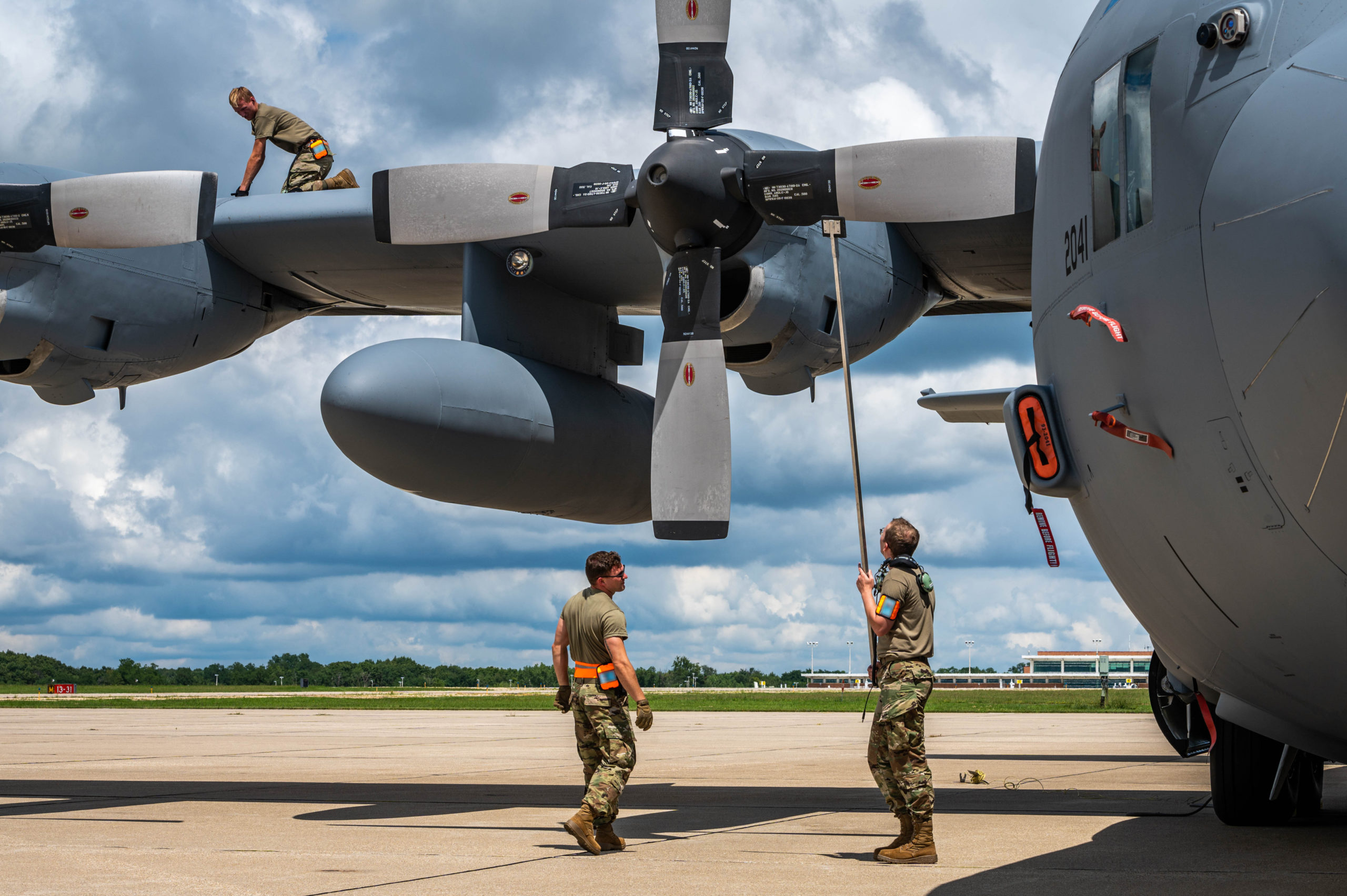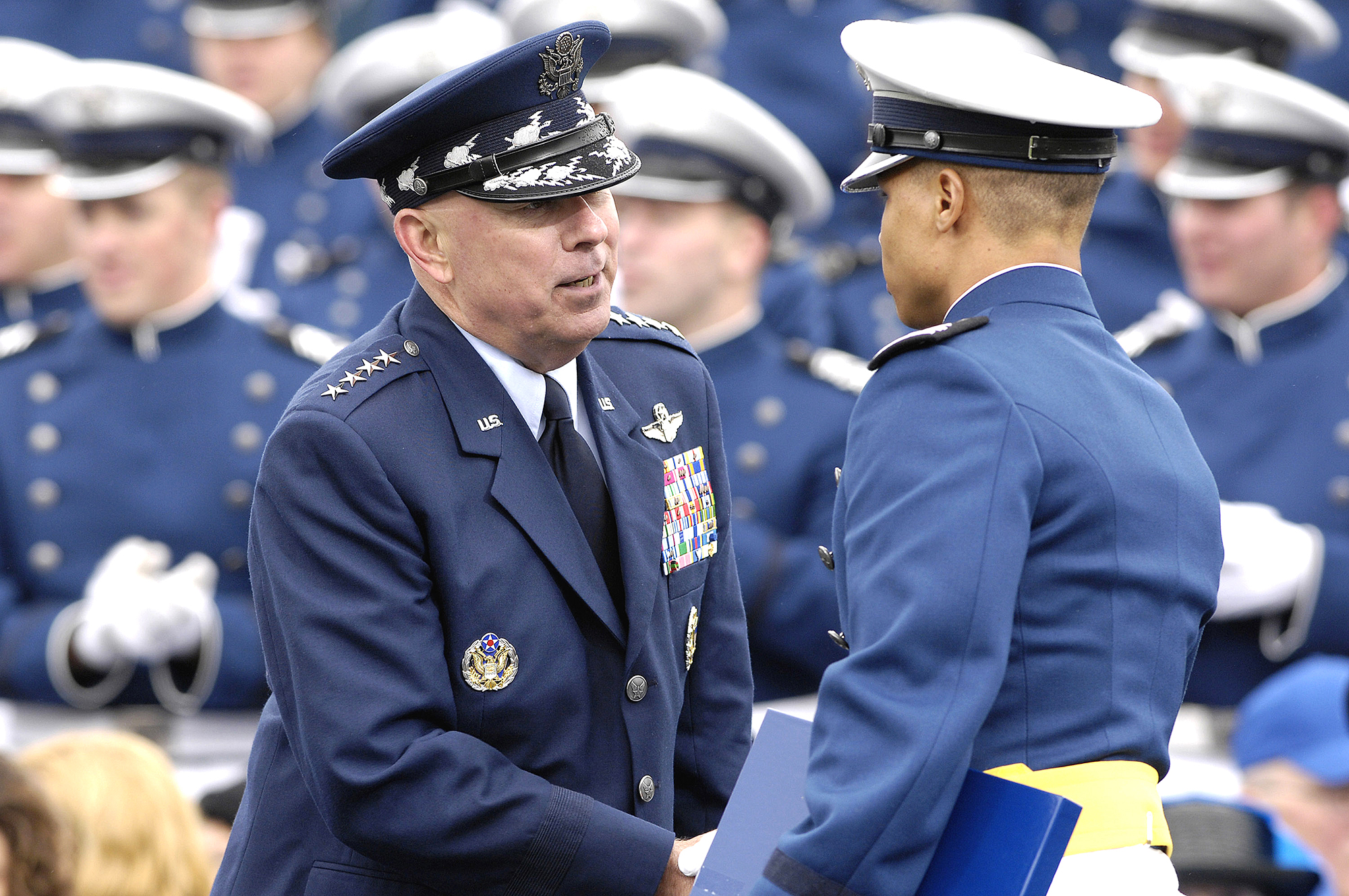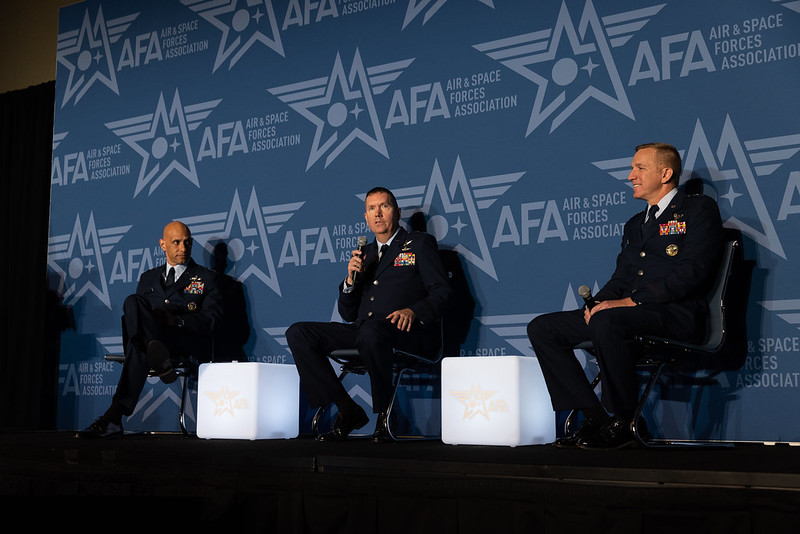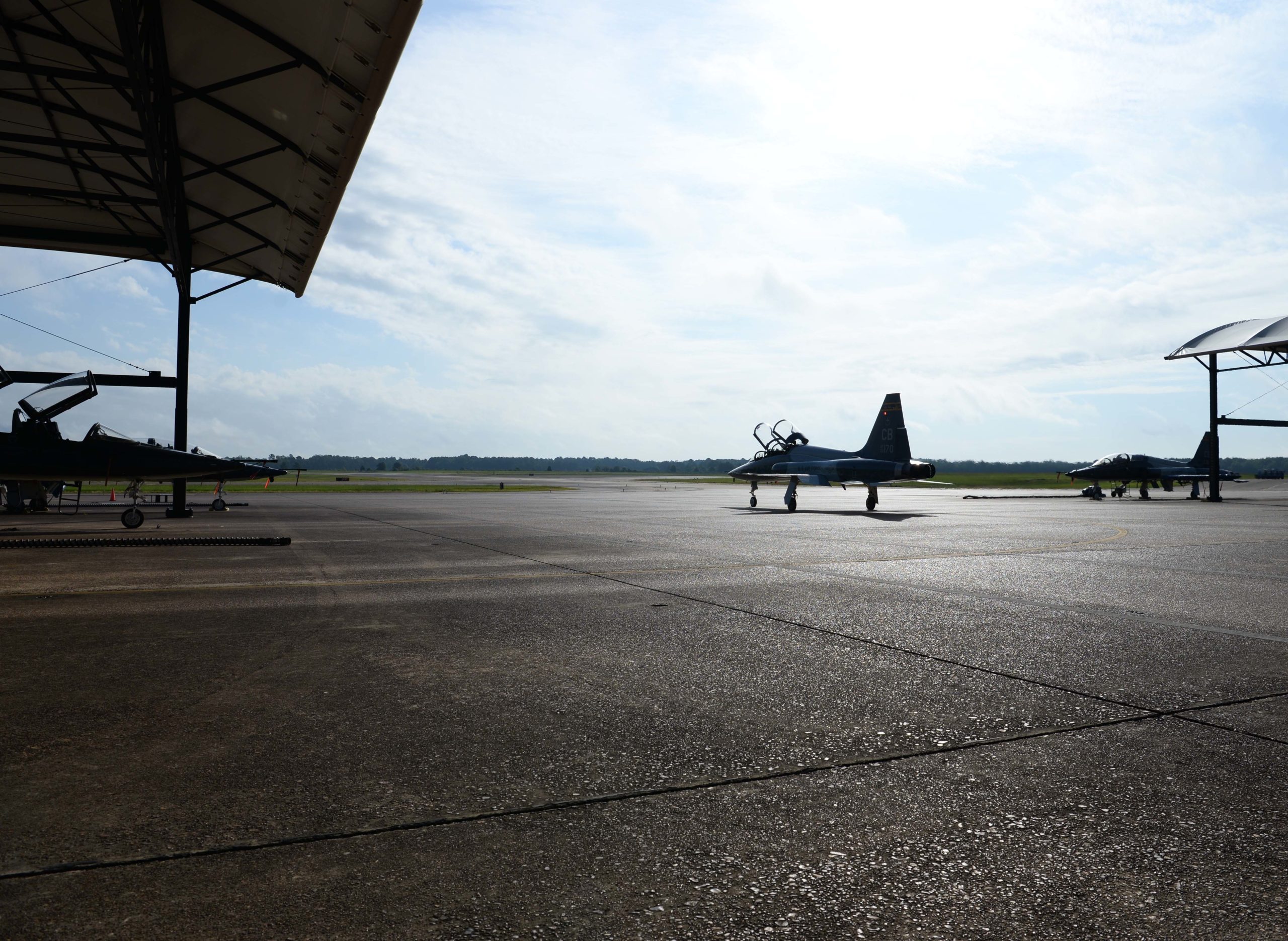In its 75-year history, 22 Airmen have led the Air Force as Chief of Staff. Each came to the post shaped by the experiences—and sometimes scar tissue—developed over three decades of service. Each inherited an Air Force formed by the decisions of those who came before, who bequeathed to posterity the results of decisions and compromises made over the course of their time in office. Each left his own unique stamp on the institution. As part of Air & Space Forces Magazine’s commemoration of the Air Force’s 75th anniversary, Sept. 18, 2022, we interviewed all of the living former Chiefs of Staff.
Gen. Larry D. Welch, CSAF No. 12 (1986-1990)
Larry D. Welch never planned to stay in the Air Force, let alone become Chief of Staff. Having enlisted in 1951, Welch was a one-striper, temporarily marching new recruits around Lackland Air Force Base, Texas, when he led a group to a briefing about the aviation cadet program. When it was over, interested recruits were asked to put a card in the basket.
Welch, who was standing in the back of the room waiting to escort the recruits to their next stop, put his name on a card and dropped it in the basket. Soon after, he was summoned to a captain’s office; the captain praised his scores and sent him for further testing. “At the end of that, I had two choices,” Welch said. “I could go into a program that would make me a second lieutenant and a pilot, or a program that would make me an Airman First Class electronics technician.”
It wasn’t a hard decision.
Time after time over the course of the next three-plus decades, Welch came to a fork in the road and found another opportunity waiting for him. He served in fighter units in Europe, the continental United States and Alaska, deployed to Vietnam, and held a series of leadership posts at Tactical Air Command. He shepherded President Ronald Reagan’s strategic programs through the budget and approval process—the B-1 and B-2 bomber programs, the M-X intercontinental ballistic missile, and two cruise missile programs—as deputy chief of staff for programs and resources, and in July 1984 he was promoted to Vice Chief of Staff, replacing Gen. Jerome O’Malley.
Welch hoped to finish his career leading Strategic Air Command, and Air Force Chief Gen. Charles Gabriel already envisioned his succession plan. “I don’t think I’m breaking any confidence here,” Welch said. “The plan was that Jerry O’Malley was supposed to be Charlie Gabriel’s replacement, but Jerry didn’t have any real fighter time. So Jerry would go to command [Tactical Air Command] for a couple of years, I would take SAC for a couple of years, and then when Jerry became Chief, I would go to TAC.”
Tragically, however, O’Malley died on April 20, 1985. The CT-39 Sabreliner executive jet he had taken to a Boy Scout event landed flawlessly that day in Wilkes-Barre, Pa., but when the pilot applied his breaks, nothing happened. A hydraulic valve in the landing gear had broken, and the airplane overshot the end of the runway, and then down a 110-foot embankment, where it burst into flames—killing everyone on board.
“That threw everything up in the air,” Welch said. “Jerry O’Malley would have been a great Chief. I’m sorry that he didn’t get to do that.”
Welch was an obvious candidate to replace O’Malley at TAC, but the nuclear enterprise was a primary focus for President Reagan and Secretary of Defense Caspar “Cap” Weinberger. The Air Force put forward one three-star after another for promotion to four-stars and command of SAC. “The SecDef turned down all three nominees,” Welch recalled. “Secretary Weinberger was having no part of that. He wanted someone he knew, and that someone was me.”
So Welch got to command SAC, the job he’d envisioned as his last in uniform, what he calls now “the pinnacle of my career.” And not many months later, Secretary of the Air Force Donald Rice came out to visit him, asking questions that in retrospect were about the Chief’s job. “It was certainly clear to everyone that I was sure as hell not campaigning to be Chief,” Welch said. But not long after, Rice let him know he was putting Welch’s name forward to succeed Gabriel.
GOLDWATER-NICHOLS
Welch became Chief July 1, 1986. Almost exactly three months later, Congress passed the Goldwater-Nichols Department of Defense Reorganization Act on Oct. 4, a revolutionary and sweeping measure that reformed the leadership structure of the armed forces and changed the future of career and assignment policy. The new law elevated the Chairman of the Joint Chiefs and redefined the operational chain of command, which now flowed from the President, through the Secretary, and down to the unified Combatant Commands—bypassing the service chiefs. Air Force and Army Chiefs of Staff, the Chief of Naval Operations, and the Marine Corps Commandant now became responsible solely for manning, training, and equipping the force. They were no longer in the business of executing war plans.
But change came slowly.
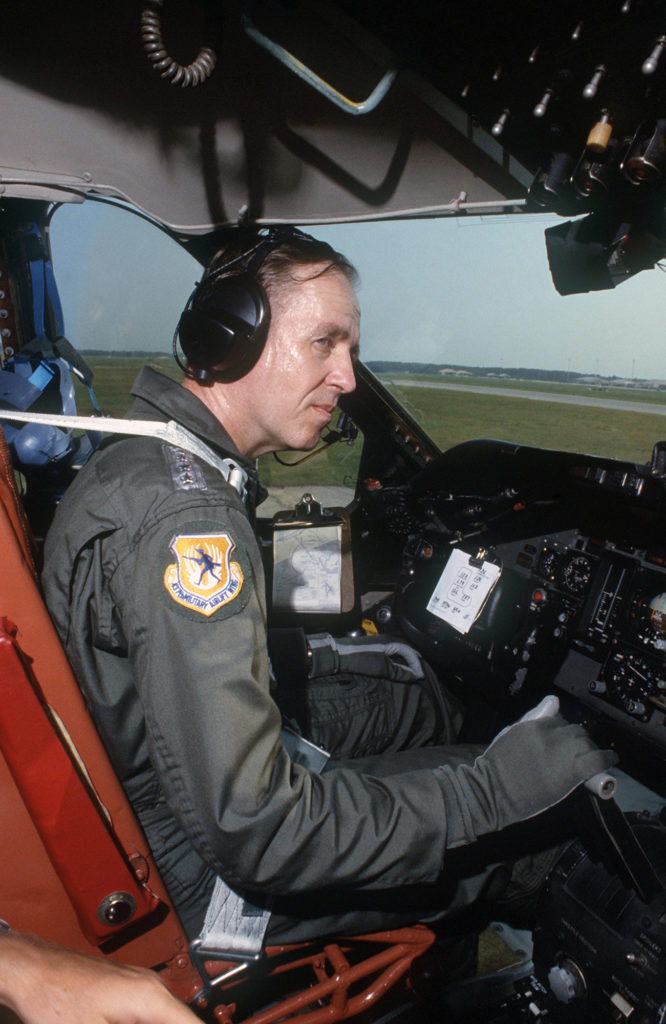
“Goldwater-Nichols didn’t change much of anything for a significant period of time,” Welch recalled. “So during the four years, … the principal effect was that they added authority to the combatant commanders. It didn’t relieve the service chiefs of any responsibility for that period of time. Well, just for example: In order to respond to Goldwater-Nichols, the combatant commanders were invited to the big high-level reviews. There used to be only the secretaries and some of the assistant secretaries and service chiefs. [Now the combatant commanders] attended those meetings—they were invited—[but] they didn’t say anything. They just observed. Because they were supposed to have a new role, but they were totally unprepared to fulfill it.”
Welch said that three of the four service chiefs were very supportive of the new law, and that in his view there was only one major flaw in the legislation: its requirements for joint tours. “It was unreasonable and unexecutable,” he says now. “But we worked around that.”
Changing the culture across the services, however, was not automatic. When the commander of the U.S. Navy’s Pacific Fleet, Adm. James A. “Ace” Lyons Jr. declined to follow the orders of his regional combatant commander, U.S. Pacific Command’s Adm. Ronald J. Hays, Lyons was forced to resign. “The issue was over sending PACFLEET ships into CENTCOM’s area of operations,” Welch said. It was the summer of 1987, and “PACFLEET absolutely defied it. And in order to correct that, the Joint Chiefs went to the Secretary of Defense, who went to the President.” Lyons’ career ended with his retirement that Oct. 1.
“I don’t think that ever would have happened without Goldwater-Nichols,” Welch said. “That was an interesting lesson to people, that—Hey! The authority of a combatant commander is a serious thing, and you had better pay attention to it.”
The impact on the service chiefs and how they operated as the Joint Chiefs of Staff was greater. “The first real effect of Goldwater-Nichols was a sort of a too-rapid move to the Joint Staff,” Welch said. “The relationship to the Joint Staff changed faster and more dramatically. In the first place, the Joint Staff began to exercise a lot more authority on service programs. And that caused a lot of angst, and it didn’t work very well.”
Suddenly more officers from other services, with less experience, were asking questions and getting involved in programs that they didn’t necessarily understand. The balance of power was now shifting, moving away from the service chiefs and their domain expertise to a joint staff whose priorities were not necessarily the same. This involvement only grew over time.
“When I was a service chief … maybe 5 percent of our program had issues with … the highest-level meeting, with the SECDEF and the undersecretaries,” Welch said. Today, however, “a service chief would probably tell you 50 percent of his program is seriously affected by the Joint Staff and OSD [Office of the Secretary of Defense]. I don’t know if that’s good or bad,” Welch said, “I just know that the service chief is the leading expert in that domain, and the service chief’s staffs are the real experts in that domain. … And I think that remains a problem.”
Welch says the net effect of these extra layers of review has not been effectiveness, but inefficiency. He notes that in his day, “our criteria was five to seven years to field an increment of new capability.” There was logic to that, because “Five to seven years was about as far as we could see geopolitically, it was certainly as far as we could see technologically, and it was probably as far as we could see in terms of tactics and strategy. Well, now the average time has doubled, while the horizons have shortened.”
The longer timeline for programs is not the fault of the services, Welch said: “The reason for that is all the other people who have a say in those decisions.”
The world was more predictable during the Cold War.
The Chiefs also began to lose clout with the White House. Another change that made a big difference, “which surprised us,” Welch said, was the elevation of the Chairman to be the principal military adviser to the Secretary and President. Prior to that time, the Chiefs had acted together, an organizational design that required the Chairman to be first among equals, rather than plainly first among all. “I didn’t think that was a big deal while I was there,” Welch said. But it became a big deal later.
In Welch’s time, the Chiefs and then-Chairman Adm. William J. Crowe had an understanding, which came about this way: “Bill Crowe came into the tank one day and reported on a meeting he had just been to in the White House,” he recalled. Immediately after that meeting, the Army Chief of Staff went into Bill Crowe’s office and said, ‘OK, Mr. Chairman, if you don’t need to consult us before you go to the White House—if you don’t need our best advice before you go to the White House—then we’ll just send our vice chiefs to tank, and we’ll do what we really like: that is, run the Air Force and the Army.’ Bill said, ‘Whoa, whoa, whoa, whoa. I apologize.’ And that never happened again with Bill Crowe.”
As members of the JCS rotated, however, that understanding faded. “Fast forward to the next Chairman and new members of the Joint Chiefs,” Welch said. “It became a reality then that the Chairman kept the service chiefs informed. … Let me tell you, we never would have accepted that.”
Indeed, the supremacy of the Chairman over the Joint Chiefs would play a decisive role in the fate of Welch’s successor.
When Welch took office in July 1986, at the very the height of the Cold War, he brought with him expertise accumulated over a career that had included a tour as vice chief of staff and as commander in chief of Strategic Air Command—CINC SAC. The security dynamic was largely bipolar in those days: East-vs.-West, USA-vs.-USSR. But now that was changing.
“By the time I became Chief, it was fairly obvious to the Joint Chiefs that the Cold War was winding down,” Welch said. Soviet Premier Mikhail “Gorbachev was making speeches about the Soviet economy. Now, I can’t say any of us thought that the Soviet Union would disappear in 1991. But it was very clear the Cold War was winding down.”
The Chiefs were convinced the services would have to pay a “peace dividend”—a budget cut as the reward to taxpayers for footing the bill for Cold War defense. But they were also convinced that the future would be unpredictable.
“We faced up to the fact that we were going to be in a new world, and we were not going to be in a world where we would have 50 years to learn to deal with things,” Welch said. “We didn’t oppose a modest decrease in the defense budget, because our logic was, there’s going to be a demand for a peace dividend, so let’s do three years of modest sacrifice to give us time to figure out this brave new world.”
It would take far longer than that, of course. “Here we are, 35 years later, and we still haven’t figured out this brave new world,” he says today. Indeed, the point illustrates something that Welch has very much on his mind today: “The fact is the service chief’s job is really far more complex today than it was when we had a single adversary that were really understood.”
The job was simpler in those days too because Americans were more united. “We had strong support on the Hill,” Welch said. “It wasn’t Republican versus Democrat. There was hardly a person on the Hill that I couldn’t get help from on some issue. They might not be any help on other issues, but Congress, OSD, the Joint Staff—everybody came together in ways that helped service chiefs do their jobs.” And where there was opposition, he said, there was nevertheless respect, especially for the system.
“The Joint Chiefs were totally at odds with Cap Weinberger on Arms Control,” Welch said. “We were totally in charge of it. Cap Weinberger hated it. … [But] he accepted the fact that we had a different view, that we were going to present our view to Congress. He disagreed with us, but he honored our view. That kind of attitude really helped the service chiefs do their job.”
As the three-star on the Air Staff responsible for programs and resources, Welch had worked with his colleagues in operations and requirements to develop a system for getting things done in the Pentagon. First they laid out their concepts of operations and the means by which the Air Force would accomplish its missions. “Then we laid out roadmaps for how we developed the set of capabilities required to do [those missions]: We had the fighter roadmap, the airlift roadmap, the bomber roadmap, the munitions roadmap. And the Air Staff tied into those roadmaps.”
Chief of Staff of the Air Force Gabriel rallied behind their effort, setting it in motion, and when Welch became Chief, he supported it, as well. The second process component Welch saw as valuable was the decision structure.
“This decision structure let the right people make the inputs at the right time,” Welch said. “The one-star level dug into great detail and they sent them to the Air Staff Board, and the Air Staff Board was the two-star level. And the two-star level examined this topic and brought their expertise, and then it went to the Air Council, and the Air Council was chaired by the Vice Chief. Then we put all that together and then it went to the secretariat. And so we had this process that was very well developed. It was very effective. And it was fast.”
Welch estimated that the Air Force could move a program from the Air Force Secretary level to the Secretary of Defense in a matter of days. “The result was we always went forward with a very solid Air Force position.” Over the years, however, some of those decision points migrated out of the service and into the Joint Staff or OSD, removing service control and slowing down decisions.
While Welch is loath to criticize successors—“I never second-guess the Chief because the only way you can do that is if you know everything the Chief is dealing with at the time, and there’s no way to know that”—he sees flaws in some choices since he was in charge. Among the larger mistakes, he said: The elimination of Air Force Systems Command in 1990, soon after his departure.
“I was very much opposed to doing away with Systems Command,” Welch said. “The Secretary [of the Air Force Don Rice] wanted for two years to do that, and I absolutely refused to go along with it. And of course, that happened one month after I retired.”
Welch saw a fundamental flaw in combining the Air Force’s sustainment operations with its weapons development experts. “Systems Command’s mission was about the future,” Welch explained. “Logistics Command’s mission was about today. So if you look at the inbox of the commander of Materiel Command, it’s full of today problems: I’ve got to get all this stuff delivered, I’ve got to get all this stuff where it needs to be. … That’s part of the reason why things started taking longer.”
Systems Command was also tightly linked to its customers: the four-star Tactical Air Command, Strategic Air Command, and Military Airlift Command. Welch recalled how he was the plans chief at TAC, and how the commands worked so well together. “Four times a year, the commander of Systems Command and commander of TAC would meet at Langley [Air Force Base, Va.,] and go over all of the primary Air Force programs to ensure that Systems Command and TAC and the Air Staff—the Air Staff was there too—were in lockstep. That’s pretty powerful.”
But the real tragedy of giving up Systems Command was that it blurred the Air Force’s vision. “Doing away with Systems Command did away with the central focus on building a future force,” Welch said. “Not sustaining the force. Not supporting the force. But building the force. That went away.”
LEARNING FROM AIRMEN
Because he began his career as an enlisted Airman—the only Air Force Chief to do so—Welch is often asked if that made a difference in his leadership. He is quick to say it did not. “I never served enough time as enlisted to gain much from that,” he said. “I can claim having close contact with senior NCOs that really made my career possible, and that had an enormous influence on me as Chief. But I really can’t claim having been a real enlisted man.”
Two NCOs in particular changed his career. The first was in France, where Welch was sent as a new captain to help convert four National Guard squadrons into an Air Force wing. Welch wanted to get checked out in the F-34, but his commander wanted him to build a combat operations center. “Within six months in this whole new mission, we have to pass the NATO TAC eval,” his commander told him. “You build that combat operations center, we pass that TAC eval, and you can pick any squadron you want.”
Welch went through a door and found a field desk, a telephone, and a senior master sergeant—little else. “I’ll tell you: I got credit for building the COC and a lot of credit for us passing the TAC Eval. All the credit really goes to that senior master sergeant, who taught me that I was responsible. He would not make a decision. He would give me advice. I had to make the decision. And I always took his advice.”
Later, Welch was pressed into duty as a squadron operations officer as a major, just as his unit was deploying to Alaska with the then-brand-new F-4 Phantom. “We had to arrange everything,” Welch recalls. “What made that possible was the senior master sergeant who worked for me. He just knew how to do everything. … So as a captain, I had this great reputation because of a senior master sergeant, and as a major I acquired this reputation largely because of a senior master sergeant. And I never forgot that.”
- Chiefs, Part 1: Discordant Visionary
- Chiefs, Part 2: A Quest for Stability, A Last Stand on Integrity
- Chiefs, Part 3: Like Father, Like Son
- Chiefs, Part 4: ‘I Tried to Always Make Things Better’
- Chiefs, Part 5: ‘Buzz Was Right’
- Chiefs, Part 6: ‘The Accidental Chief’
- Chiefs, Part 7: ‘Surviving the Budget Control Act Debacle’
- Chiefs, Part 8: The ‘Joint’ Chief
- Chiefs, Part 9: ‘Last of the Cold War Chiefs’
- Chiefs, Part 10: ‘The Invisible Chief’

